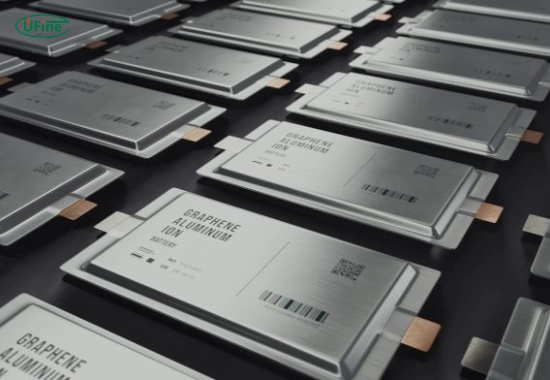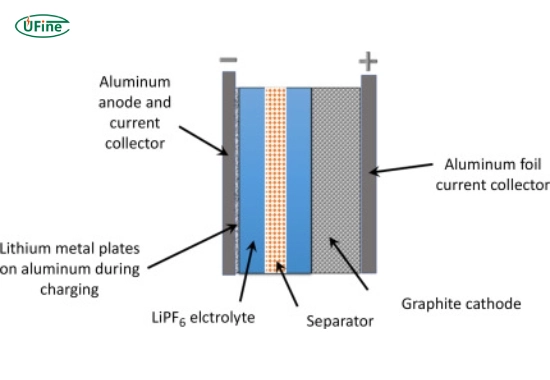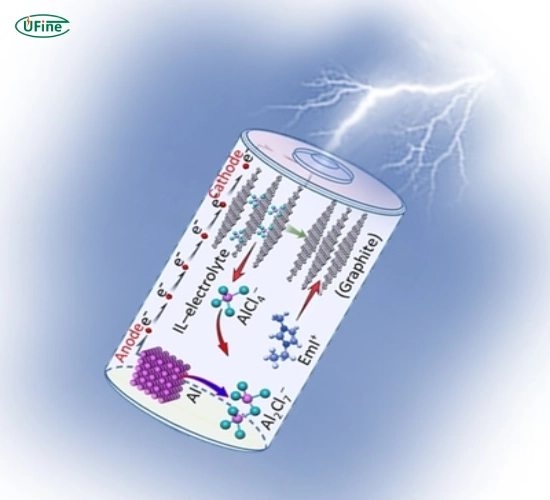Energy storage is essential in our modern world. From powering our smartphones to running electric vehicles, we rely on batteries more than ever. Aluminum-ion batteries (AIBs) are a new and exciting technology that could change the way we store energy. Researchers are developing them as an alternative to lithium-ion batteries, the most popular rechargeable battery type. But what makes aluminum-ion batteries different? How do they work, and why should we care? In this article, we’ll explore these questions and more.
Part 1. What are aluminum-ion batteries?
Aluminum-ion batteries (AIBs) are a type of battery that uses aluminum ions (Al³⁺) to store and release energy. Unlike lithium-ion batteries, which use lithium ions (Li⁺), AIBs rely on aluminum as their main component. This difference is significant because aluminum is more abundant, cheaper, and safer than lithium.
The basic structure of an aluminum-ion battery includes three main parts:
- The anode: This is made of aluminum metal and is the source of aluminum ions.
- The cathode: This part stores the aluminum ions during charging and releases them during discharging. Common materials for the cathode include graphite or other conductive materials.
- The electrolyte is a liquid or gel that allows aluminum ions to move between the anode and cathode.
What makes AIBs unique is their ability to store more energy due to the unique properties of aluminum ions. Aluminum ions carry a charge of +3, compared to lithium ions, which carry a charge of +1. This means AIBs can theoretically store more energy in the same material.
Part 2. How do aluminum-ion batteries work?
How aluminum-ion batteries work is simple yet fascinating. Like rechargeable batteries, they operate through a cycle of charging and discharging. Here’s how it works step by step:
Charging process
When you charge the battery, a voltage is applied. This forces aluminum ions (Al³⁺) to leave the aluminum anode and travel through the electrolyte to the cathode, storing energy in the battery.
Discharging process
When you use the battery, the aluminum ions travel back from the cathode to the anode. This movement releases the stored energy, which can power devices like phones or cars.
One unique feature of aluminum-ion batteries is their fast charging capability. Research has shown that AIBs can charge in minutes, compared to the hours it takes for some lithium-ion batteries. This is because aluminum ions move more efficiently through the electrolyte.
Another key point is the durability of these batteries. Aluminum-ion batteries don’t degrade as quickly as lithium-ion batteries, meaning they could last longer and need fewer replacements.
Part 3. Why are aluminum-ion batteries essential?
Aluminum-ion batteries are gaining attention for several good reasons. Here are some of the key benefits that make them stand out:
1. Abundance of aluminum
Aluminum is one of the most abundant elements on Earth. It is much easier to find and extract than lithium, which is found in only a few locations worldwide. This makes aluminum-ion batteries more sustainable.
2. Lower cost
The cost of producing aluminum-ion batteries is significantly lower than that of lithium-ion batteries. Aluminum is cheaper than lithium, and the manufacturing process is less expensive, too. This could make AIBs a more affordable option for many applications.
3. Increased safety
Lithium-ion batteries have a reputation for catching fire or exploding under certain conditions. Aluminum-ion batteries, on the other hand, are much safer. They are less likely to overheat or experience “thermal runaway,” a dangerous chain reaction that can cause fires.
4. Faster charging
Imagine charging your phone or electric car in just a few minutes. Aluminum-ion batteries have the potential to make this a reality. Their unique chemistry allows them to recharge much faster than lithium-ion batteries.
5. Eco-friendly
The production of -ion batteries has a minor environmental impact compared to lithium-ion batteries. Aluminum mining is less damaging to the Earth, and the batteries themselves are easier to recycle.
Part 4. What are the challenges facing aluminum-ion batteries?
While aluminum-ion batteries have many advantages, they could be better. Scientists are still addressing significant challenges to make these batteries widely usable. Here are the main issues:
1. Cathode materials
Finding the right material for the cathode is one of the biggest challenges. Graphite is commonly used but could be better for storing aluminum ions. Researchers are exploring other materials to improve the battery’s performance.
2. Lower energy density
Energy density refers to how much energy a battery can store relative to its size. Currently, aluminum-ion batteries have a lower energy density than lithium-ion batteries, so they can’t store as much energy in the same space.
3. Electrolyte stability
The electrolytes in aluminum-ion batteries must be stable and efficient. However, finding an electrolyte that works well with the anode and cathode has proven difficult.
4. Cycle life
The cycle life of a battery refers to how many times it can be charged and discharged before it stops working. Aluminum-ion batteries must demonstrate a longer cycle life to compete with lithium-ion batteries.
Part 5. Applications of aluminum-ion batteries
Many industries could use aluminum-ion batteries. Here are some potential applications:
1. Renewable energy storage
AIBs could store energy from solar panels and wind turbines. Their low cost and safety make them ideal for large-scale energy storage systems.
2. Electric vehicles (EVs)
With their fast charging and lower cost, AIBs could be a game-changer for electric cars. Researchers need to improve energy density before replacing lithium-ion batteries in this field.
3. Consumer electronics
Aluminum-ion batteries’ fast charging and long-lasting nature could benefit devices like smartphones, tablets, and laptops.
4. Industrial equipment
Aluminum-ion batteries could power heavy machinery and equipment, especially in industries where safety and reliability are critical.
Part 6. How do aluminum-ion batteries compare to lithium-ion batteries?
Aluminum-ion batteries and lithium-ion batteries are different in many ways. Here are the key differences:
- Cost: Aluminum-ion batteries are cheaper to produce because aluminum is abundant and inexpensive.
- Safety: Aluminum-ion batteries are safer and less likely to overheat or catch fire.
- Energy density: Lithium-ion batteries currently have a higher energy density, meaning they can store more energy in a smaller space.
- Charging speed: Aluminum-ion batteries charge much faster than lithium-ion batteries.
- Environmental impact: Aluminum-ion batteries are more eco-friendly and straightforward to recycle.
Here’s a table summarizing the differences:
| Feature | Aluminium Ion Batteries | Lithium-Ion Batteries |
|---|---|---|
| Cost | Lower | Higher |
| Abundance | High (aluminium is widely available) | Low (lithium is limited) |
| Safety | Safer | Less safe (risk of overheating) |
| Energy Density | Lower | Higher |
| Charging Speed | Faster | Slower |
| Environmental Impact | Lower | Higher |
Aluminium Ion Battery vs Lithium-Ion: A Detailed Comparison
Part 7. What are the environmental benefits of aluminum-ion batteries?
One of the most exciting aspects of aluminum- ion batteries is their potential to reduce environmental damage. Here’s why:
- Abundant resources: Aluminum is easy to find and mine, unlike lithium, which is concentrated in a few regions.
- Lower carbon emissions: Producing aluminum-ion batteries generates fewer greenhouse gases compared to lithium-ion batteries.
- Recyclability: Aluminum is highly recyclable, which means less waste and fewer materials ending up in landfills.
- Reduced mining damage: Lithium and cobalt mining often cause severe damage to ecosystems, while aluminum mining has a smaller environmental footprint.
Part 8. Who is developing aluminum-ion batteries?
Many companies and research institutions are working on aluminum-ion batteries. Some notable players include:
- Stanford University: Scientists here have created a prototype AIB that charges in just one minute.
- Graphene Manufacturing Group (GMG): This company is exploring the use of graphene in AIBs to improve performance.
- Chinese research teams: China invests heavily in AIB technology, especially renewable energy storage.
These efforts are pushing the technology closer to commercial use. Scientists believe that with continued research, aluminum-ion batteries could soon become a viable alternative to lithium-ion batteries.
Part 9. FAQs
-
What makes aluminum-ion batteries better than lithium-ion batteries?
Aluminum-ion batteries are cheaper, safer, and more environmentally friendly than lithium-ion batteries. They also charge faster, making them ideal for applications that require quick charging. -
Why are aluminum-ion batteries yet to be widely used?
Aluminum-ion batteries are still in the research and development phase. Before they can be used commercially, challenges such as low energy density, limited cycle life, and finding suitable cathode materials must be addressed. -
Can aluminum-ion batteries replace lithium-ion batteries in electric vehicles?
Still waiting. While aluminum-ion batteries charge faster and are safer, their lower energy density means they cannot yet store enough energy to power electric vehicles over long distances. However, ongoing advancements may make this possible in the future. -
Are aluminum-ion batteries more sustainable?
Yes, they are much more sustainable. Aluminum is abundant, more effortless to mine, and recyclable, making aluminum-ion batteries a more eco-friendly option compared to lithium-ion batteries, which rely on scarce and environmentally damaging materials like lithium and cobalt. -
How soon will aluminum-ion batteries be available?
It’s hard to say precisely when aluminum-ion batteries will be commercially available. Still, researchers are optimistic that we could see practical applications within 5–10 years, especially for grid energy storage and other large-scale uses.
Related Tags:
More Articles

How to Choose the Best Floor Scrubber Battery for Commercial Cleaning?
Selecting the ideal floor scrubber battery ensures a long runtime, rapid charging, and minimal maintenance for efficient commercial cleaning operations.
Battery for Blower vs Battery for Leaf Vacuum: Which One Should You Choose?
Battery for blower vs leaf vacuum—learn the key differences in power, fit, and runtime to choose the right battery for your outdoor tool needs.
How to Choose the Right Battery for Blower?
Choosing the right blower battery? Consider voltage, capacity, chemistry & usage. This guide helps match the best battery for peak performance.
How to Choose the Best Insulated Battery Box for Lithium Batteries?
Choosing the Best Insulated Battery Box for Lithium Batteries? Discover key factors such as size, material, and safety for optimal protection and performance.
7 Critical Elements on a Lithium Battery Shipping Label
What must be on a lithium battery shipping label? Learn 7 key elements to ensure safety, legal compliance, and correct handling across all transport modes.






